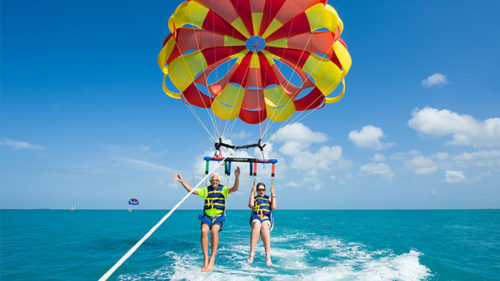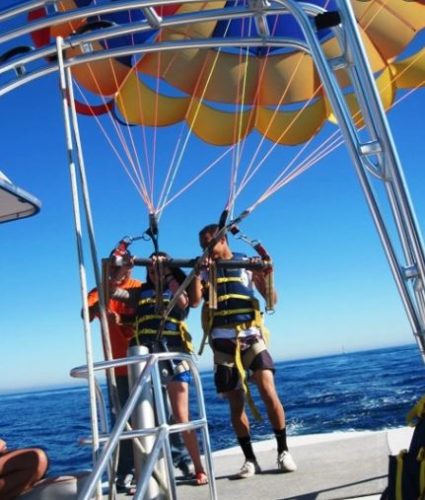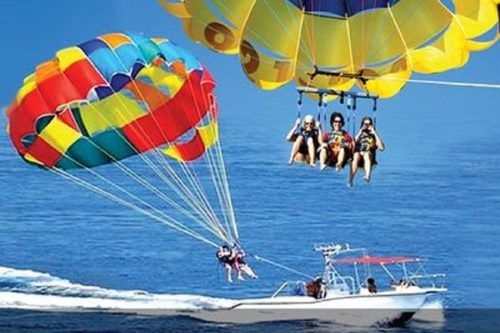You may be thinking about going parasailing at some point in the near future but aren’t quite sure how it works or whether it’s considered a safe activity.
This guide will shed some light on this very popular, recreational kiting activity so that you know exactly what to expect when you plan your trip.
How parasailing works
Parasailing is a joyride in which a person or group of riders (known as parascenders) are harnessed to a parachute, called a kite or parasail, and towed in the air by a vehicle over land or water.
When the towing vehicle drives off and picks up speed, the rider ascends to about 300 or 500 feet in the air and glides forward or in circles at about 15 to 30 mph.

The parascender has little to no control over the canopy wing, which is why parasailing is essentially a thrill ride whereby people just sit and enjoy the experience of flying (while taking in a panoramic view of the surrounding landscape).
The vast majority of recreational parasailing is done over water with a motorboat (by millions of people each year). Most commercial operators require parascenders to take-off from the flight deck of the boat (not from the water).
Do you land in water when parasailing?
No, landing in water is rare (unless it’s for a competitive sport). For the average person, water landings are only used in emergency situations. The standard landing procedure involves being winched gently back on the boat’s flight deck.
Try to relax in the event of a water landing. You are unlikely to get hurt—just wet. Water landings involve the boat crew releasing a safety pin that allows the parascender to float slowly into the water (wearing life vests).

Should you know how to swim?
Swimming is not part of parasailing since riders take off and land on the flight deck of the towing vehicle. Of course, to ease any anxiety you may have of landing in water (even with a life vest), it is recommended that you know how to swim.
Is parasailing scary?
Not really.
Millions of people parasail each year. For the vast majority of them, parasailing is an exhilarating or even relaxing experience. This is because parasailing, under ideal weather conditions, is a controlled experience in which you glide peacefully through the air.
For first-timers, the scariest moments during parasailing are probably during take-off and dipping (which is when you brush your feet in the water and fly back up). That’s probably the only time you may feel butterflies in your stomach. But it’s not an absolutely necessary part of the ride.
Who should not parasail?
People with an uncontrollable fear of heights, or a nervous heart condition, probably should not parasail because they wouldn’t fully enjoy the experience.
That being said, parasailing is considered physically safe for most people young or old. It’s not a shocking experience. Even if you happen to briefly pass out, you are completely secure while harnessed to the kite.
Parasailing safety concerns for first-timers
What is too windy for parasailing?
You should not parasail in excessively windy conditions for several reasons. For one, it’s riskier to land in high winds. Therefore, try to avoid the activity when winds are sustained at 15 mph or higher. Most commercial operators will ban parasailing at winds above 20 mph.

What is the weight limit for parasailing?
Weight limits depend on the weather conditions, type of parasailing rig, and whether it’s a solo or tandem ride. Typically, the maximum combined weight limit is 500 lbs. That means up to 3 people can safely parasail together.
Can you fall out of a parasail harness?
No, falling out of your harness is nearly impossible. You are securely strapped to a seat with back support, meaning you don’t need to hold on to anything with your hands.
Safety by the numbers
Parasailing is very safe. Millions of Americans go parasailing each year. But like any recreational outdoor activity, first-timers may be concerned about safety. So it helps to know the facts.
Between 1982 and 2012, there were about 1,800 injuries and 72 deaths due to parasailing accidents in the United States (according to the Parasail Safety Council). That’s roughly 2.4 deaths per year during that time period. When you consider that about 150 deaths are caused by falling coconuts each year, it’s apparent that parasailing is statistically very safe.
And due to measures to increase industry regulation and enforce safety standards over the last decade, parasailing is safer today than it ever was.
Safety checks and tips for first-timers
- Pay attention to any pre-flight safety briefing (it should guide you on how to comfortably take-off and land).
- Don’t participate if you notice any weathered or frayed equipment.
- Choose a well-established commercial operator with insurance.
- Do not parasail in bad weather (including sustained winds over 15 mph)
- Flying 600 feet or more beyond the towboat increases risk.
When is the best time to parasail in Hawaii?
The best time to parasail in Hawaii depends on the weather and how busy it is.
The busy seasons are from July to early September and mid-December to March. The off-seasons are from April to mid-June and September to early December. Busier months mean higher prices and longer wait times.
The rainy (or wet) season is from November to March. This means a higher chance of rainy or stormy weather. Months with the highest average wind speeds are from June to August.

Can you parasail in Hawaii in January?
Yes, you absolutely can (if the weather is good). In fact, January is the calmest month in terms of wind speed. It’s a beautiful time of year despite being part of Hawaii’s rainy season. It’s also a popular time for travelers to visit from colder climates around the world.
What weather is best for parasailing?
Clear blue skies and low wind speeds create the best weather conditions for parasailing. That means the water is calm and you get a panoramic view of the natural landscape. High winds of 15 mph or more can be risky and make it more difficult to take-off and land.
